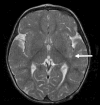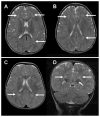Subtle hemorrhagic brain injury is associated with neurodevelopmental impairment in infants with repaired congenital heart disease
- PMID: 19619781
- PMCID: PMC2752843
- DOI: 10.1016/j.jtcvs.2009.02.027
Subtle hemorrhagic brain injury is associated with neurodevelopmental impairment in infants with repaired congenital heart disease
Abstract
Objective: Perioperative stroke and periventricular leukomalacia have been reported to occur commonly in infants with congenital heart disease. We aimed to determine the incidence and type of brain injury in infants undergoing 2-ventricle repair in infancy and to determine risk factors associated with such injury.
Methods: Forty-eight infants enrolled in a trial comparing 2 different hematocrits during surgical repair of congenital heart disease underwent brain magnetic resonance imaging scans and neurodevelopmental testing at 1 year of age.
Results: Eighteen (38%) of our subjects had tiny foci of hemosiderin by susceptibility imaging, without evidence of abnormalities in corresponding regions on conventional magnetic resonance imaging sequences. Subjects with foci of hemosiderin had a significantly lower Psychomotor Developmental Index at 1 year of age (79.6 +/- 16.5, mean +/- standard deviation) compared with subjects without these foci (89.5 +/- 15.3; P = .04). Older age at surgery and diagnostic group were significantly associated with the presence of hemosiderin foci. Only 1 subject had a small stroke (2%), and 2 subjects had periventricular leukomalacia (4%).
Conclusion: Foci of hemosiderin without radiologic evidence of ischemic brain injury are an abnormality associated with adverse neurodevelopmental outcome not previously described in magnetic resonance imaging studies of children with surgically repaired congenital heart disease. The association of hemosiderin foci with older age at surgery and cardiac diagnosis, and not with risk factors associated with brain injury, in previous studies suggests that the cause and pathogenesis of this abnormality are different from ischemic brain lesions reported previously.
Trial registration: ClinicalTrials.gov NCT00006183.
Figures




References
-
- Bellinger D, Jonas R, Rappaport L, Wypij D, Wernovsky G, Kuban K, et al. Developmental and neurologic status of children after heart surgery with hypothermic circulatory arrest or low-flow cardiopulmonary bypass. New Eng J Med. 1995;332:549–555. - PubMed
-
- Miller G, Tesman J, Ramer J, Baylen B, Myers J. Outcome after open-heart surgery in infants and children. J Child Neurol. 1996;11:49–53. - PubMed
-
- Bellinger DC, Wypij D, Kuban KC, Rappaport LA, Hickey PR, Wernovsky G, et al. Developmental and neurological status of children at 4 years of age after heart surgery with hypothermic circulatory arrest or low-flow cardiopulmonary bypass. Circulation. 1999;100(5):526–32. - PubMed
-
- Bellinger DC, Bernstein JH, Kirkwood MW, Rappaport LA, Newburger JW. Visual-spatial skills in children after open-heart surgery. J Dev Behav Pediatr. 2003;24(3):169–79. - PubMed
-
- Bellinger DC, Wypij D, duDuplessis AJ, Rappaport LA, Jonas RA, Wernovsky G, et al. Neurodevelopmental status at eight years in children with dextro-transposition of the great arteries: the Boston Circulatory Arrest Trial. J Thorac Cardiovasc Surg. 2003;126(5):1385–96. - PubMed

